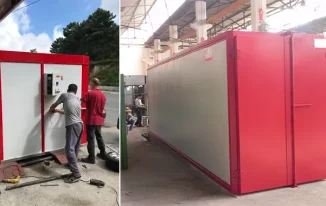Powder coating is as much a science as it is an art. At the heart of the process lies the interplay between heat and time—two factors that determine whether a powder-coated surface becomes a flawless, durable finish or a disappointing misfire. Powder coating ovens are the unsung heroes in this story, orchestrating the precise conditions needed for perfection.
Harmony Between Heating Rates and Coating Adhesion
A powder coating oven does more than just heat metal—it crafts a bond that can endure the test of time. When the powder is applied to a substrate, it requires a precise ramp-up in temperature to melt evenly and adhere to the surface. Rushing this process can result in powder that clumps or fails to flow, leaving imperfections in the finish. On the other hand, heating too slowly might cause the powder to sag before it cures, leading to uneven layers or weak adhesion.
The ideal heating rate ensures the powder melts uniformly without disturbing its distribution across the substrate. Powder coating ovens, designed with advanced airflow systems, maintain this balance, ensuring heat envelops every curve and crevice of the object. Mastering this heating dance is vital, as proper adhesion is what gives powder-coated surfaces their resilience against chipping, corrosion, and wear.
Critical Thresholds for Avoiding Overcuring or Undercuring
Temperature control in powder coating ovens is more than a technicality; it’s a matter of getting the chemistry just right. When an oven’s heat exceeds the powder’s tolerance, overcuring occurs, leading to brittle finishes or discoloration. Conversely, undercuring leaves the coating soft and prone to peeling or scratching.
Powder coating ovens typically operate in the range of 350°F to 450°F, but even a few degrees can tip the balance. It’s not just about the right temperature—it’s about sustaining it evenly across the entire chamber. Uniform heat distribution prevents localized overcuring or undercuring, ensuring the entire surface achieves the same level of durability.
Precision Timing to Achieve Uniform Surface Finishes
In powder coating, timing isn’t just a guideline—it’s the rulebook. Once the powder reaches its melting point, the clock starts ticking. Most powders require 10 to 30 minutes at a consistent temperature to cure properly, but the exact time depends on the object’s size, shape, and material.
Powder coating ovens equipped with precise timers and sensors play a critical role in hitting this sweet spot. Overshooting the cure time can compromise the finish’s integrity, while cutting it short risks leaving uncured particles. The result? Flawed coatings that don’t meet durability or aesthetic expectations. Precision timing ensures that every inch of the surface has time to melt, flow, and solidify into a seamless, uniform finish.
Impact of Temperature Fluctuations on Coating Integrity
Fluctuating temperatures can turn a promising powder coating session into an unpredictable gamble. Inconsistent heat levels within a powder coating oven can cause uneven curing, leading to imperfections such as bubbles, dull patches, or inconsistent textures.
Modern powder coating ovens combat this challenge with robust insulation and cutting-edge thermostatic controls, ensuring temperature stability throughout the curing chamber. By minimizing heat loss and maintaining consistent air circulation, these ovens guarantee that every part of the object receives uniform treatment. Temperature stability is not just a convenience—it’s essential for achieving coatings that last.
Balance of Energy Efficiency and Optimal Performance
Operating a powder coating oven isn’t just about achieving results; it’s about doing so efficiently. Energy-efficient ovens minimize operating costs while maintaining the high performance needed for consistent curing. Features like thick insulation, advanced heat recovery systems, and energy-smart designs help strike this balance.
The efficiency of powder coating ovens doesn’t just save money—it also improves overall production timelines. Faster heat-up times mean less downtime between batches, allowing for higher throughput without sacrificing quality. Achieving this balance ensures businesses can deliver durable finishes while managing resources responsibly.
Fine-Tuned Controls for Managing Variable Curing Requirements
Not all powder coatings are created equal. Different powders, substrates, and part dimensions require fine-tuned adjustments to the curing process. Powder coating ovens equipped with programmable controls make it easier to adapt to these varying requirements.
By allowing users to set precise temperatures, airflow rates, and cure times, these ovens bring flexibility and consistency to complex projects. This adaptability ensures that intricate or irregularly shaped objects receive the same flawless finish as standard parts, no matter how challenging the specifications.
Relationship Between Thermal Stability and Longevity of Coatings
The durability of a powder-coated surface often comes down to thermal stability. A consistent curing temperature in the oven ensures that the coating bonds completely to the substrate. This thorough bonding process is what gives powder-coated finishes their reputation for resilience and long-lasting performance.
Powder coating ovens built for thermal stability provide more than just immediate results—they contribute to the lifespan of the finish. From resisting environmental stressors to withstanding mechanical wear, coatings cured under stable conditions maintain their integrity far longer than those exposed to temperature fluctuations.














